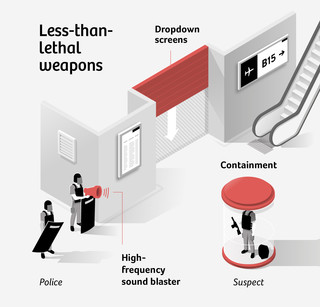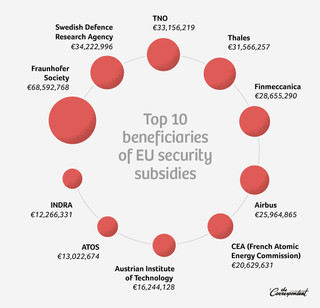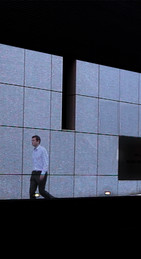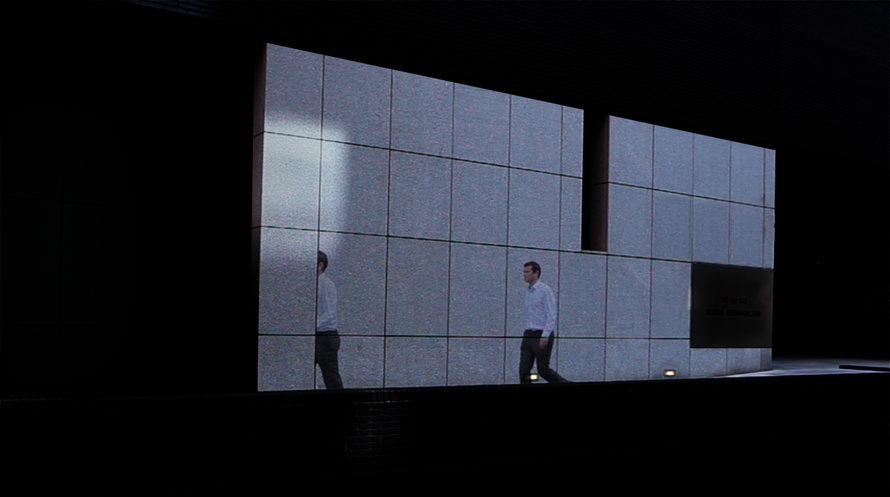The Swedish researcher points at the giant black-and-yellow-striped blaster. “Shall I test it out on you?” He reaches toward the funnel-shaped device. A mannequin stands a few yards away, wearing a cheap jogging suit and a bright yellow suicide vest. We give a nervous laugh and politely decline the offer.
It’s June 1, 2016 and we’re exploring the Security Research and Innovation Event the European Commission is holding in The Hague. Here, researchers are presenting the results of seven security projects the Commission has funded with more than €63 million in grants.
And those aren’t the only projects funded by the Commission. The Commission has been trying to boost the security industry for ten years now, and nearly €2 billion has already been funneled into security research.
Our international consortium of 22 European journalists from 11 countries wants to find out what that €2 billion in subsidies has accomplished. In total, we speak with nearly one hundred people involved, in Brussels and in participating member states. Has it made Europe safer?
We quickly discover that the European security industry is primarily taking good care of itself – often at the expense of the public.
The civilian security industry is growing
But first: What is the European "security industry," anyway?
In the 1990s many countries lowered their defense spending, so arms manufacturers moved into the civilian security market. Drones, smart cameras that can see through clothing, and sensors that can sniff out bombs: all kinds of things were developed. In the US, the security industry is now worth more than €100 billion.
In every policy paper, the European Commission emphasizes that we’re living in a dangerous world whose threats have grown extraordinarily complex
In Europe, too, the civilian security industry has been growing for years, though no one seems to be paying much attention. According to the European Commission, surveillance companies earn some €30 billion each year on the European market, enjoy double-digit growth, and provide jobs to roughly 180,000 people.
That’s not to say the Commission is satisfied. In every policy paper, it emphasizes that we’re living in a dangerous world whose threats have grown extraordinarily complex. Time and again, the Commission insists that Europe can only become safe if we develop and deploy sophisticated technology, such as that being presented at the trade show in The Hague.
But this market isn’t yet flourishing, says the Commission. The industry is still much too focused on national concerns, and researchers aren’t collaborating enough. The Commission envisages an enormous public-private partnership of companies, private and semi-private research institutes, universities, and end users such as law enforcement and emergency services.
A sort of European Homeland Security.
An example of things gone wrong: The A-WASP
Back to the black-and-yellow-striped blaster, which turns out to be an A-WASP. The blaster is part of the European SUBCOP research project, which stands for Suicide Bomber COunteraction and Prevention, the Swedish researcher explains. The goal of that project, which received €4.6 million in funding, was to find less-than-lethal methods for taking out terrorists.
One of the plans was to install dropdown walls and ceilings. If a terrorist exploded a bomb, security personnel could make panels drop down around the terrorist to isolate him.
by Leon de Korte for The Correspondent

That plan ultimately didn’t make it to market, unlike the A-WASP, a highly directional megaphone that projects a concentrated beam of sound. If a terrorist is about to blow himself up, security personnel can use the megaphone to warn people nearby and to emit high-frequency tones to unsettle the attacker.
The sound blaster is manufactured by an English company with the Harry Potteresque name of Cerberus Black. As far as we know, no counterterrorism agencies have wagered a purchase of this giant. Cerberus Black is now trying to sell the A-WASP to local law enforcement services. According to Matt Henry, the company’s owner, the device “sounds like the worst siren you’ve ever heard.” Test subjects say it “looks like a comedy gun,” but feels as if their brains are “rattling around.”
Now police officers can use the A-WASP when “addressing the migrant crisis,” according to the Cerberus Black website. But of course that’s not what the EU’s SUBCOP funding was meant for. It was meant for counterterrorism.
So what went wrong with the black-and-yellow-striped blaster? In September we speak with Marike van der Horst and Jolanda van Deursen, two researchers at the Dutch research institute TNO, both of whom worked on SUBCOP and other EU projects.
Our conversation is a little on the prickly side, especially once we ask what concrete results the SUBCOP project accomplished. That’s not easy to measure, the researchers say. Their objective was to develop knowledge and forge international networks of companies, end users, and researchers. The final technology is in the hands of Cerberus Black, and TNO no longer has a say in that.
How this security industry was able to emerge
But enough about SUBCOP – after all, it’s only one of the more than 458 security projects the European Commission has funded so far. And the striking thing is: all these projects came about some ten years ago, thanks to the urging of the arms industry and a few high-ranking European officials.
The idea for the grants was launched in 2003 by the Group of Personalities. This one-time advisory body to the Commission was populated by:
- top brass from defense companies such as Thales, Finmeccanica, BAE Systems, and EADS (now Airbus),
- representatives from tech companies like Siemens and Ericsson, and
- a number of senior government officials.
Not represented in the group: scientists and civil society organizations.
In the group’s final report, the defense companies and government officials urged the development of research programs focused on technology that could be used both on the battlefield and in everyday life. Public-private partnerships would be key in rapidly readying this technology for the market, so that both industry and society could benefit, according to the group.
The EU listened and freed up a handsome sum for the programs. The grants got off to a modest start, with a budget of €65 million in 2004. But in 2007 FP7 began, and seven years later Horizon2020, in which some €3 billion was reserved for security research. Roughly two-thirds of that has now been disbursed.
Who received those millions in funding?
Where did that money go? Our investigation shows that eleven of the twelve private parties in the Group of Personalities have received funding. At €33 million, the Dutch research institute TNO has received the third-largest research grant. Group members Thales (€32 million), Finmeccanica (€29 million), and Airbus (€25 million) are also in the top ten.
The bulk of the funding, more than €1.1 billion, went to companies and research institutes. Most research institutes, including TNO and Germany’s Fraunhofer, focus on applied research and are dependent on private clients.
Roughly €18 million went to interest groups, including the European Organization for Security (EOS), a defense industry lobbying group founded in 2007.
by Leon de Korte for The Correspondent

How did those organizations score that money? The companies that received funding have a strong lobby. Employees, usually acting as private individuals, are members of expert groups that advise the Commission on new research grants. Delegates from the EOS lobbying group also routinely have a seat in these kinds of advisory bodies. And the EOS itself also organizes conversations between the industry and EU policy makers.
The major arms manufacturers are also members of the Aerospace and Defence Industries Association (ASD) lobbying group, and we counted sixty lobbyists who work to influence European Parliament members on their behalf. In addition, some manufacturers are regularly invited by EU member states to pull up a chair at the usually closed European Council meetings.
At Milipol, a large homeland security trade show in Paris, a delegate from a French defense company who spoke to us on condition of anonymity reveals why companies participate in these kinds of advisory bodies. “The goal is to land contracts in order to sell the technology later. We learn how the EU works, and we can help guide the requirements that will be posed.” He then adds, “We’re not a humanitarian organization.”
by Leon de Korte for The Correspondent

Oddly enough, emergency services such as police and fire departments – that is, the organizations that will actually use the technology – are rarely at the table, or are only there in small numbers. Consider the PASAG, a council that advises the EU on the security research the Horizon2020 program should support. The panel contains just one organization that directly represents end users: the European Network of Law Enforcement Technology Services (ENLETS).
As a result, the technology that gets developed, like the A-WASP, doesn’t meet real-world needs, ENLETS chairman Patrick Padding tells us. The innovation programs often focus on developing highly advanced technology. “But we don’t always want the latest gadgets; we’d rather have, say, a simple app that works on old smartphone models. Our needs are often quite modest.”
That realization has since sunk in at the European Commission. After a press conference in The Hague, a senior official tells us it’s been difficult to find an audience for the projects’ results. The Commission is now working to improve that by involving end users earlier in the process. But in the past, at least, customers have been hard to find.
But has all of this made us safer?
In 2015 the Commission published a report on how its first €1.4 billion in funding for new technology research was spent. The surveyed recipients were positive about the results and praised the opportunities to work with other organizations. The report also contained critical notes.
The research projects have generated few scientific publications: an average of three per project, in contrast to the average of twelve for other research areas that are funded with EU money. Only a little more than half of those surveyed believe the projects’ results justify the investment. Nearly one in five felt the projects delivered too little value. Also noteworthy is the recommendation that more needs to be done to encourage the use of the projects’ results.
We conducted our own sample survey, by asking researchers what happened with the results of their research. Of the 140 project leaders we approached, only 38 answered our request for information. The rest did not respond, and thus were unable to explain how the funds were spent. Only rarely did a project lead to concrete, sellable technology. Most of them stopped at a prototype, a study, a report, or a wiki page.
One of the project leaders was the Dutch TNO. They indicated that the knowledge gained is primarily useful for furthering their other projects and for setting up collaborative projects with foreign partners.
And our research in Belgium and Germany reveals that the result of EU-funded projects is rarely tangible technology, but instead – are you ready? – case studies, catalogs, comparative studies, conferences, databases, drafts, expertise networks, guidelines, handbooks, methodologies, protocols, recommendations, reports, research plans, risk analyses, roadmaps, roundtable discussions, taxonomies, websites, and workshops.
In other words, lots and lots of paper. Tangible results are few and far between. Even in terms of scientific publications, European security research is not terribly impressive.
After research, there’s the “Valley of Death”
One of the project leaders who did respond is Jean-Luc Gala, a professor at KU Leuven in Belgium. The four EU projects for which Gala received funding did result in concrete technology, but from conversations with colleagues he knows that’s the exception and not the rule. “This is not just my personal analysis; several project coordinators feel exactly the same way. One of the problems is that three years – the average length of the research projects – is simply too short to develop something new from scratch.”
Another criticism Gala offers is the “complete lack of interest” from national governments. “That’s true not only in Belgium, but also in practically every EU country. In all seriousness: you’re the first person in ten years who’s called to ask what my EU research has accomplished.”
“You’re the first person in ten years who’s called to ask what my EU research has accomplished
Peter Löffler at Siemens, the company’s top lobbyist, reveals a brutal truth. “The projects themselves don’t interest us. We’re primarily interested in knowing what policy is being drafted, so we can focus on that. There’s what we call a Valley of Death. Only research receives funding. As soon as it’s time to make a product, no more funding is available. There may be a prototype, but nothing a customer can truly use yet.” Too much still needs to happen before that point. “So most ideas don’t survive the transition.”
The criticism from Germany’s former European Parliament member Karl von Wogau is also noteworthy. He was a member of the Group of Personalities and has always been an active cheerleader for a European security market. In late November he told us that the FP7 and Horizon2020 grants “were a step in the right direction, but hardly a success.” The projects were, and are, too small to have an impact and could just as easily have been run at the national level. In addition, he says, far too many studies are conducted and far too little concrete technology is developed.
Technology as the holy grail
Even projects the Commission lists as a success suffer from major shortcomings. Several projects culminated in EUROSUR, a collaborative effort by several Mediterranean countries intended to halt migration flows on the Mediterranean Sea. The project has cost more than €600 million and received tens of millions in research grants.
The goal is to reduce the number of illegal immigrants arriving in the Schengen Area, to reduce the number of fatalities on the Mediterranean Sea, and to combat cross-border crime. Last year at least 4,733 migrants drowned, so the second goal certainly has not been achieved.
“Let brilliant scientists get down to work, and leave them alone for five years. Over the long term that will generate far more value, in terms of innovation
EUROSUR is also plagued by other problems. For example, participating member states are not required to share data with each other, and as a result not enough sharing occurs. Ruben Andersson, an associate professor at the University of Oxford, is extremely critical of EUROSUR. “It’s a hugely ambitious undertaking, which has nonetheless received very little political scrutiny,” he says. “Despite concerns about how useful this system really is.” He reports that people who have to use the system have nothing positive to say about it.
Could those billions be better spent? Yes, says Bart Preneel, a professor of cryptography at Belgium’s KU Leuven. He says the research grants are useful because they lead to collaboration with industry, but acknowledges they don’t often result in concrete security applications. He argues in favor of making this funding primarily available for fundamental research. “Let brilliant scientists get down to work, and leave them alone for five years. Over the long term that will generate far more value, in terms of innovation. And good researchers will also want to bring those things to market.”
What creates security for some, makes others more vulnerable
There’s another problem: European companies seem indiscriminate in their pursuit of profits. On the one hand, they sell weapons and security technology to parties in the Middle East. And on the other, they earn money securing the European border – to protect the EU from problems arising in these conflict zones.
Many European companies export their wares to dictatorial regimes. Time and again, companies make the news because they’ve sold surveillance equipment that has endangered journalists, activists, and ordinary citizens. Amnesty International calculates that since 2014, twelve EU countries have sold more than €6 billion in weapons to the Egyptian army and police, despite that regime’s draconian repression.
It is striking that companies receive research grants to create solutions to problems for which they are partly responsible
There are no signs that EU funding is being abused for this purpose, but it is striking that companies receive research grants to create solutions to problems for which they are partly responsible.
There has been protest. In 2015, thirty Palestinian unions and human rights organizations signed a petition against funding for Elbit, an Israeli company that manufactures weaponry that is used against the Palestinians. The outcry fell on deaf ears, and Elbit ultimately received €3.1 million.
In addition, no one monitors what happens with the acquired knowledge and technology in a country under dictatorial rule or amid conflict once a research project ends. Participants in the SUBCOP program, for example, include Israel and Turkey, countries with a rapidly deteriorating human rights situation. Israel has received more than €38 million over the years: more than Poland and Denmark, for example. Turkish companies and institutes have received more than €5 million.
What happens to the technology that companies and institutes from these countries help to develop? Do we think it’s okay if the A-WASP, which Israel and Turkey also helped create, is used against protesters? What happened to the grants they received? What might they do with the technology? Research projects are subject to ethical requirements, but once a project ends, no one tracks what happens with the technology.
And what now?
The Commission says lessons have been learned from the completed research programs. It promises to involve end users, such as emergency services, earlier, and to better ensure that the technology developed reaches the market.
Yet history seems to be repeating itself. In 2015, a new Group of Personalities presented a plan for a military research program. According to the report, defense companies are suffering: with governments making up the bulk of their clientele, their market is small and it’s therefore “quite challenging” to invest in research and technology (R&T). The group calls on the EU to come to the industry’s aid, to ensure that non-EU companies – whose R&T is financed by the government, they say – don’t gain a competitive advantage.
This Group of Personalities doesn’t contain a single end user, such as emergency services or law enforcement. The group contains primarily representatives from major defense companies, including the CEOs of Saab, BAE Systems, Finmeccanica, and Airbus. They’ve gotten the research program they asked for: at the end of 2016, the European Commission unveiled a new military fund. Each year €500 million will be disbursed for research into innovative military technologies. The question is whether that funding truly advances the cause of the European citizen, or only that of the industry.
The European Commission has not responded to our requests for comment.
Thank you to Kristof Clerix, Kai Biermann, Guillaume Pitron, and Lorenzo Bagnoli, all co-authors of this report. This piece is part of the investigative journalism project Security for Sale, reporting on Europe’s security industry in partnership with journalists from eleven European countries. Security for Sale is made possible by Journalismfund.eu
—Translated from Dutch by Grayson Morris and Erica Moore
More from Security for Sale:
More stories from The Correspondent:

 This is how we can fight Donald Trump’s attack on democracy
The news provokes outrage every day, but it rarely inspires sustained resistance. Now that Donald Trump has launched a frontal assault on democracy, the press needs to fundamentally change tack. Journalists have to beat historians to the punch and write history – before it repeats itself.
This is how we can fight Donald Trump’s attack on democracy
The news provokes outrage every day, but it rarely inspires sustained resistance. Now that Donald Trump has launched a frontal assault on democracy, the press needs to fundamentally change tack. Journalists have to beat historians to the punch and write history – before it repeats itself.

 Looking to escape Trumpism in Canada? Think again
Canada is accepting immigrants in record numbers. We sing the praises of multiculturalism and welcome Syrian refugees with open arms. But are we strong enough to withstand the xenophobic forces seen in Europe and the US?
Looking to escape Trumpism in Canada? Think again
Canada is accepting immigrants in record numbers. We sing the praises of multiculturalism and welcome Syrian refugees with open arms. But are we strong enough to withstand the xenophobic forces seen in Europe and the US?

 Meet the greatest anti-poverty crusader you’ve never heard of
Every news item you read about poverty owes its existence to the work of one unknown but revolutionary economist. Oddly enough, he’s never gotten the media attention he deserves. Who is this Martin Ravallion, the man who put poverty on the map worldwide?
Meet the greatest anti-poverty crusader you’ve never heard of
Every news item you read about poverty owes its existence to the work of one unknown but revolutionary economist. Oddly enough, he’s never gotten the media attention he deserves. Who is this Martin Ravallion, the man who put poverty on the map worldwide?








